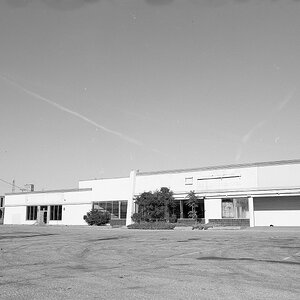epp_b
No longer a newbie, moving up!
- Joined
- Aug 22, 2008
- Messages
- 2,135
- Reaction score
- 12
- Location
- True North Cold and Freezing
- Website
- www.eppbphoto.com
- Can others edit my Photos
- Photos OK to edit
As exposure, metering and automation technology progresses for SLRs, it seems that that camera makers are building more and more of the "brains" or "guts" into the lenses for no reason other than to jack up their prices. Whatever happened to giving customers value?
Some examples...
Matrix/Average Metering
The Nikon F4 provided full matrix metering with manual lenses simply by mounting them. Not even the latest and greatest $5000 D3 can do this. You have dick around in the menus and program in your lens information to get matrix metering.
Metering is all in-camera electronics and firmware anyway, so it's not exactly a big leap to impelement this firmware across the line.
Autofocus
OK, I do understand the importance if USM/SWM technology. It's astonishingly fast and quiet, and it has instant manual override. However, anyone who's ever used Sony's AF system, which is the same concept as Nikon's original screwdriver AF system, might find in-lens AF systems a bit silly. Seriously, I used one of Sony's lowest end DSLRs and the AF is easily as fast as USM/SWM motors, and nearly as quiet. This is why I've always thought Nikon's original AF system was better in theory, just not as well implemented as it could have been (again, see Sony). As for switchless manual override, I'm sure it's possible with some clever gearing.
VR/IS
This is going to sound a bit odd coming from me as I've been a proponent of in-lens VR/IS because it's very helpful to "see" it happening. However, would it not be theoretically possible to shift both the sensor and also the mirror or some sort of optical element in the camera body that affects the viewfinder?
G lenses
I'd gladly pay an extra few bucks for an aperture ring on every lens I buy to make them fully compatible with Nikon film bodies back to the 50's. C'mon, Nikon, where's your legendary lens compatibility?
Any thing else I haven't thought of?
Some examples...
Matrix/Average Metering
The Nikon F4 provided full matrix metering with manual lenses simply by mounting them. Not even the latest and greatest $5000 D3 can do this. You have dick around in the menus and program in your lens information to get matrix metering.
Metering is all in-camera electronics and firmware anyway, so it's not exactly a big leap to impelement this firmware across the line.
Autofocus
OK, I do understand the importance if USM/SWM technology. It's astonishingly fast and quiet, and it has instant manual override. However, anyone who's ever used Sony's AF system, which is the same concept as Nikon's original screwdriver AF system, might find in-lens AF systems a bit silly. Seriously, I used one of Sony's lowest end DSLRs and the AF is easily as fast as USM/SWM motors, and nearly as quiet. This is why I've always thought Nikon's original AF system was better in theory, just not as well implemented as it could have been (again, see Sony). As for switchless manual override, I'm sure it's possible with some clever gearing.
VR/IS
This is going to sound a bit odd coming from me as I've been a proponent of in-lens VR/IS because it's very helpful to "see" it happening. However, would it not be theoretically possible to shift both the sensor and also the mirror or some sort of optical element in the camera body that affects the viewfinder?
G lenses
I'd gladly pay an extra few bucks for an aperture ring on every lens I buy to make them fully compatible with Nikon film bodies back to the 50's. C'mon, Nikon, where's your legendary lens compatibility?
Any thing else I haven't thought of?










![[No title]](/data/xfmg/thumbnail/33/33025-0e4fc16dd87a477880f7aa74466d4f56.jpg?1619735838)
![[No title]](/data/xfmg/thumbnail/33/33027-0118cfc4034a37ef267ca6f8aa2fe04a.jpg?1619735841)
![[No title]](/data/xfmg/thumbnail/30/30861-fee88082ba36d0c3b443492fe3f3f1cd.jpg?1619734481)
